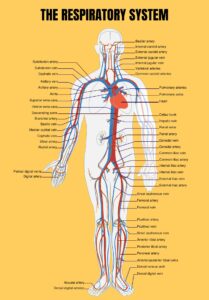Breathing Life: The Biology of the Human Respiratory System
by Yuvi K - December 16, 2023
Breathing Life: The Biology of the Human Respiratory System
Our human respiratory system is a complex and intricate network of organs and tissues. It ensures that every single cell in the body is able to receive oxygen, which gives us energy and sustains life. The respiratory system is one of the most important systems in the body, and malfunctioning in any organ or tissue can be life-threatening. Understanding the anatomy and physiology of the human respiratory system and the vital role oxygen plays in the body is key in maintaining optimal health.
Overview of the Human Respiratory System
The primary organs of the human respiratory system include the nose, nose cavity, larynx, trachea, bronchi, and lungs.

(नाक, नाक की गहराई, गले, ट्रैकीया, ब्रोंकी और फिर फेफड़े)
The process of breathing itself is driven by the diaphragm (दांतागमन) muscle. The diaphragm helps to regulate the pressure in the chest cavity. When we breathe in, the diaphragm contracts and moves the chest downward. This creates a vacuum effect which causes the lungs to expand and draw air into the lungs. When we breathe out, the diaphragm relaxes and pushes the chest back up, expelling the air.
How Oxygen Enters the Body
Oxygen enters the body through the nose or mouth and is taken to the lungs by the bronchial tubes. Here, it binds with hemoglobin (हीमोग्लोबिन) molecules in red blood cells. Hemoglobin is a protein molecule that helps to carry oxygen around the body. The oxygen then travels from the lungs to the other organs and tissues in the body via the bloodstream.
The Role of Oxygen in the Body
Oxygen is essential for the body as it enables cells to produce energy. Cells use glucose and oxygen to create energy in the form of adenosine triphosphate (ATP). ATP is then used by the cells for their various functions. Without oxygen, cells cannot produce energy and eventually die.
Removing Carbon Dioxide from the Body
The respiratory system also plays a vital role in removing carbon dioxide (CO2) from the body. Carbon dioxide is a byproduct of cellular respiration and must be removed from the body. When we breathe out, carbon dioxide is expelled from the lungs. In this way, the respiratory system helps to regulate the pH balance in the body.
The Impact of Poor Respiratory Health
It is important to take care of our respiratory system to ensure that our bodies get enough oxygen and stay healthy. Poor respiratory health has a variety of implications, from shortness of breath and fatigue to more serious conditions such as asthma, chronic obstructive pulmonary disease (COPD) and pneumonia.
It is essential to take precautions such as avoiding smoking and air pollution, as well as getting vaccinated for pneumonia. Eating a healthy diet, exercising regularly and getting enough sleep can also help to keep the respiratory system healthy.
Conclusion
The respiratory system is a complex and vulnerable network of organs and tissues. Understanding the anatomy and physiology of the human respiratory system and the vital role oxygen plays in the body is key in maintaining optimal health. Taking good care of our respiratory system is the best way to ensure that our bodies get enough oxygen and stay healthy.


